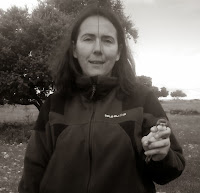AG: Deseada, you have been studying birds in the
south of Spain over the last 19 years. What made you so passionate about these
animals?
DPM: I don't
know exactly, but it is true that although I love animals in general, birds are
my favorite. Perhaps because their ability to fly away - and hence to escape - is challenging for us.
AG: One of
the birds you studied is the European Roller, one of the most colourful birds
we have in the Iberic peninsula. What are the traits of its biology that you
find surprising?
DPM: There
are many Roller traits that I find really astonishing. They migrate every year
to all over Europe from South Africa and back. Their sexual displays are
amazing, with rolling flights through which they exhibit the full range of
their marvellous colours to one another. Males and females fully share
incubation and parental care until the end of the nestling stage. There is also
the surprising behaviour of nestlings that expel out an orange liquid (some
kind of vomit) when they are disturbed at nests. Probably a defensive
behaviour against nest predators.
AG: You also studied the effect of installing
nest-boxes. What are the main results?
DPM: Roller
conservation plans have often relied on nest-box provisioning to improve
breeding populations. However, patterns of nest-box occupancy and breeding
success had never been explored for this species. We investigated in the south
of Spain the efficacy of nest-box provisioning by analysing nest-box selection
for breeding and reproductive performance. Our results indicate that nest-boxes
should not be installed in too easily detectable locations, where breeding
failure is more likely, or in highly concealed locations, which are probably
undetectable for prospecting Rollers. Finally, future conservation plans for
this species should aim to avoid placing nest-boxes near motorways and near
patches of almond groves or pine plantations. Instead, conservation plans
should promote combined plans of nest-box provisioning with the creation of a
mosaic of alternating herb crops and woody groves to enhance the probability of
colonization by Rollers.
AG: How do you see the future of the roller in
Extramadura and in the Alentejo? What is the current state of the populations?
DPM: I think
that in Extremadura and in the Alentejo, Rollers have healthy populations. The
main threat for the species in the area is agricultural intensification and the
habitat loss it leads to (removal of trees) as well as the use of pesticides.
AG: What are your own research projects in the
future? Are there still mysteries regarding the roller that you would like to
clear up?
DPM: I will
continue to deepen my knowledge of the biology of this amazing species. In
particular, I´m very interested in studying the species outside of the
Peninsula during its migratory journey. Many birds never return from Africa. It
could be interesting to investigate the threats that the species is under
during winter time. Also, I would like to learn more about the nature of the
defensive vomit that I mentioned above.
AG: What is the most special moment you
remember during your observations of rollers in the field?
DPM: Capturing some breeding adults is always a unique moment as rollers are very intelligent
birds. They usually detect all sorts of artefacts that we use to catch them.
So, when you succeed to capture one of them it is really great. And they also defend themselves very aggressively when they are handled…
.JPG)


Aucun commentaire:
Enregistrer un commentaire